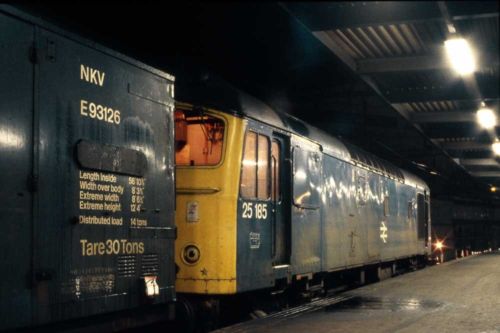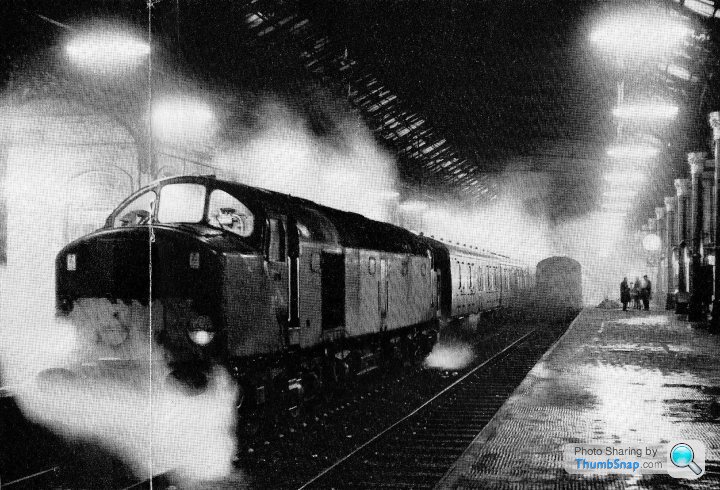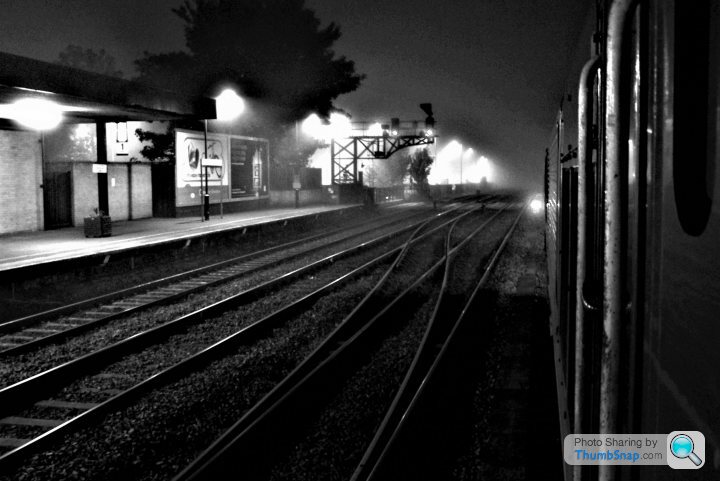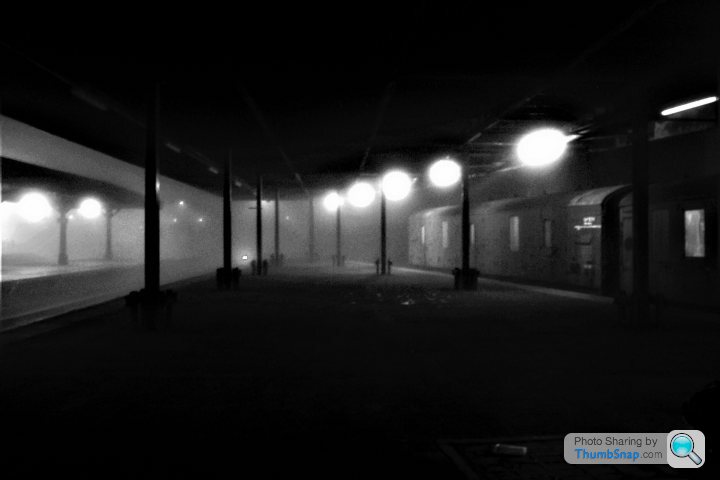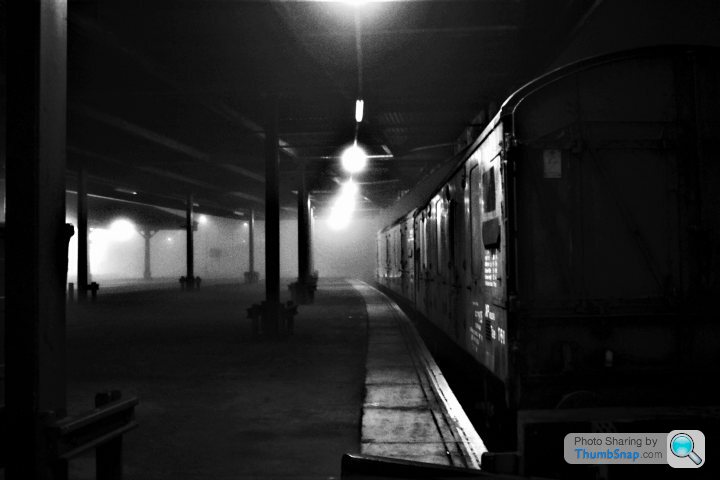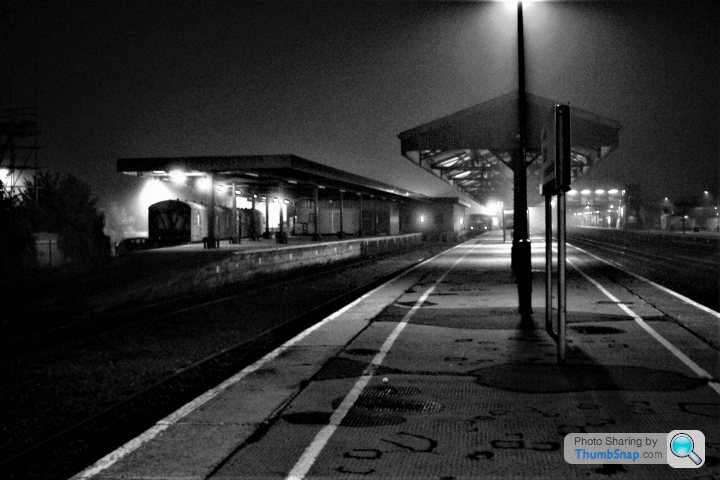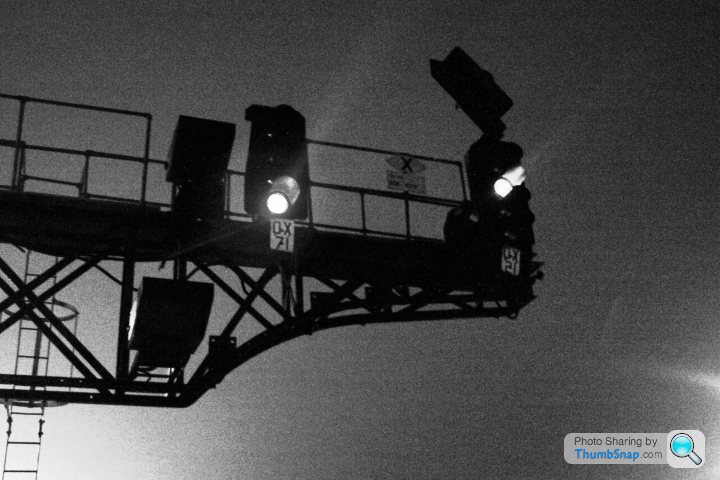Loco sheds and other railway buildings...
Discussion
P5BNij said:
wolfracesonic said:
‘Very thrashable’, care to expand?
The 50s we had at Old Oak were used day in, day out on the Paddington to Oxford and Newbury commuter trains which had quite tight timings, once you were clear of the 25mph speed restriction through the pointwork you could open them right up and keep the power on until shutting off for the first stop. They really used to fly and could take quite a bit of abuse but the power handle had an initial 'notch' which you had to be careful with, if you tried to go to full power straight away without pausing on that notch you'd get a slight thump in the back then nothing.
 What’s are fastest accelerating trains that have or are been used on our railways? I’m guessing traction is just as important as outright power. Great thread btw.
What’s are fastest accelerating trains that have or are been used on our railways? I’m guessing traction is just as important as outright power. Great thread btw.Great thread
Why has the class 20 continued in service for so long?
I know most of them run in pairs but would it have not been better to rebuild something like a 31 or 37 or 47 rather than the 20 which must be compromised when running as you dont have the benefits of a cab at each end.
In fact why did such a design get signed off when every other loco apart from small shunters has a dual cab?
Why has the class 20 continued in service for so long?
I know most of them run in pairs but would it have not been better to rebuild something like a 31 or 37 or 47 rather than the 20 which must be compromised when running as you dont have the benefits of a cab at each end.
In fact why did such a design get signed off when every other loco apart from small shunters has a dual cab?
wolfracesonic said:
 What’s are fastest accelerating trains that have or are been used on our railways? I’m guessing traction is just as important as outright power. Great thread btw.
What’s are fastest accelerating trains that have or are been used on our railways? I’m guessing traction is just as important as outright power. Great thread btw.bristolracer said:
Great thread
Why has the class 20 continued in service for so long?
I know most of them run in pairs but would it have not been better to rebuild something like a 31 or 37 or 47 rather than the 20 which must be compromised when running as you dont have the benefits of a cab at each end.
In fact why did such a design get signed off when every other loco apart from small shunters has a dual cab?
I believe that the Class 20 survived the rationalisation/Modern Traction Plan because:Why has the class 20 continued in service for so long?
I know most of them run in pairs but would it have not been better to rebuild something like a 31 or 37 or 47 rather than the 20 which must be compromised when running as you dont have the benefits of a cab at each end.
In fact why did such a design get signed off when every other loco apart from small shunters has a dual cab?
1) It worked. It was virtually the only low-power mainline diesel loco on BR that had decent reliability.
2) With 1000hp and 75tons on four axles it had a very low axle weight and a very flexible wheelbase, making it ideal for working lightly-laid colliery lines and other industrial branches
3) They could be coupled nose to nose, solving both the type's visibility problems and the fact that the BR Modernisation Plan had completely failed to forsee the need for general-purpose freight locos in the 2000hp range - the adoption of bulk single-good freight trains and merry-go round coal trains meant that all the hundreds of 1000-and-a-bit-horsepower Type 2 locos procured in the late 50s/early 60s really struggled. Fortunately there were loads of Class 20s (made redundant by the evaporation of the short-distance pick-up and trip goods work they were intended for) which could be paired up to become very useful 2000hp eight-axle units.
4) They share a lot of mechanical and electrical bits with other popular classes (40 and 37) and are dead simple in design and essentially unbreakable, making them easy to keep going. They can work in multiple with other common BR diesel classes, making them useful 'booster' units to 37s and so on on heavy trains.
As for why they've been kept around. Rather like the 37s, They Just Work. Procuring brand new 1000hp diesel locos to replace them would be very expensive (one of the American or European manufacturers would have to adapt one of their standard designs to the UK loading gauge and it would have to meet all the modern emissions rules. Meanwhile 20s and 37s get grandfathered in to keep spreading sound, fury, smoke and soot around the place. These days cameras on the nose have circumvented the visibility issue and if, like DRS, you only need 1000hp to run a nuclear flask train, a railhead treatment rig or something else short and light why use something with 2000+ hp?
They had the cab at one end because that's just how small diesel locos at the time were built - everyone was used to steam locos. It was an adaptation of a standard English Electric design which was also sold to railways in New Zealand, Portugal and Australia.
BR wanted to replace the Class 20 (or EE Type 1 as it was then) with the twin-engine centre-cab Clayton (later Class 17) which was supposed to be a British version of an American 'road switcher' (enough power to run on the main line, enough grunt for shunting, good visibility in both directions and equipment for carriage heating) but the Claytons were so direly unreliable that BR ordered an extra batch of Class 20s to replace them - the class that was supposed to be their replacement!
Thanks again 2xC 
It’s worth noting that some of the older types still in use have been refurbished and or re-engined more than once to keep them going, for example a batch of 47s were completely refitted in the 2000s and renamed as Class 57s.
I’m currently on my break at Lawley Street terminal in Brum having just backed a train in with a 66, whistfully remembering all the classes that used to work in the area regularly back in BR days - 08s, 20s, 24s, 25s, 31s, 37s, 40s, 45s, 46s, 47s, 50s and 56s, even the odd 27 or 33 would appear occasionally in the ‘60s. Saltley loco depot is little more than a signing on point now but back then there were around 1200 train crew based there.

It’s worth noting that some of the older types still in use have been refurbished and or re-engined more than once to keep them going, for example a batch of 47s were completely refitted in the 2000s and renamed as Class 57s.
I’m currently on my break at Lawley Street terminal in Brum having just backed a train in with a 66, whistfully remembering all the classes that used to work in the area regularly back in BR days - 08s, 20s, 24s, 25s, 31s, 37s, 40s, 45s, 46s, 47s, 50s and 56s, even the odd 27 or 33 would appear occasionally in the ‘60s. Saltley loco depot is little more than a signing on point now but back then there were around 1200 train crew based there.
P5BNij said:
I’m currently on my break at Lawley Street terminal in Brum having just backed a train in with a 66, whistfully remembering all the classes that used to work in the area regularly back in BR days - 08s, 20s, 24s, 25s, 31s, 37s, 40s, 45s, 46s, 47s, 50s and 56s, even the odd 27 or 33 would appear occasionally in the ‘60s. Saltley loco depot is little more than a signing on point now but back then there were around 1200 train crew based there.
Lawley Street back in he day… 
2xChevrons said:
The loco that had brought the train would be uncoupled, then another loco would be attached to the other end - either on another service or a station pilot would take the empty carriages off to be stabled/serviced at carriage sidings.
The loco at the buffer stops could (carefully) follow the carriages it had brought in down the platform as they were drawn out until it reached the signal at the end of the platform, where it had to wait for the line to be clear. Then it could be shuffled across to another platform to work an outbound service (brought in by another loco now 'trapped' at the buffers), head to the refuelling/stabling point just outside the station throat or be sent up the line to Finsbury Park.
This is one of the big operational advantages of multiple units and power cars - a huge reduction in shunting/light engine movements at terminii, quicker turnarounds and the railway can eliminate a lot of pointwork and signalling. Very efficient but it makes the railway much less interesting than they were.
Great thread. Out of interest, how did the shunting work? ie for every train that terminated where the tracks ended, did they have to de-couple the loco, shunt the carriages out to a siding, move the loco out the way, shunt the carriages back into the station, and then drive the loco to the front? Must have been a major and very time-consuming operation and at big stations. The loco at the buffer stops could (carefully) follow the carriages it had brought in down the platform as they were drawn out until it reached the signal at the end of the platform, where it had to wait for the line to be clear. Then it could be shuffled across to another platform to work an outbound service (brought in by another loco now 'trapped' at the buffers), head to the refuelling/stabling point just outside the station throat or be sent up the line to Finsbury Park.
This is one of the big operational advantages of multiple units and power cars - a huge reduction in shunting/light engine movements at terminii, quicker turnarounds and the railway can eliminate a lot of pointwork and signalling. Very efficient but it makes the railway much less interesting than they were.
Amazing now when you think how quickly inbound trains are turned around ready to depart again.
Venisonpie said:
How do the cabs fare with multiple users? Having driven trucks for a living 25 years ago one of the downsides was taking over a vehicle from a messy fecker who left rubbish/coffee cups/fag ash etc.
Eventually I had a dedicated vehicle but obviously not possible on the railway.
In S Wales during the late 60s and 70s we knew that if we were relieving Saltley men the footplate would be a mess. Guards vans would have little coal or oil for the lampsEventually I had a dedicated vehicle but obviously not possible on the railway.
Edited by loggo on Wednesday 26th January 10:46
yeager2004 said:
2xChevrons said:
The loco that had brought the train would be uncoupled, then another loco would be attached to the other end - either on another service or a station pilot would take the empty carriages off to be stabled/serviced at carriage sidings.
The loco at the buffer stops could (carefully) follow the carriages it had brought in down the platform as they were drawn out until it reached the signal at the end of the platform, where it had to wait for the line to be clear. Then it could be shuffled across to another platform to work an outbound service (brought in by another loco now 'trapped' at the buffers), head to the refuelling/stabling point just outside the station throat or be sent up the line to Finsbury Park.
This is one of the big operational advantages of multiple units and power cars - a huge reduction in shunting/light engine movements at terminii, quicker turnarounds and the railway can eliminate a lot of pointwork and signalling. Very efficient but it makes the railway much less interesting than they were.
Great thread. Out of interest, how did the shunting work? ie for every train that terminated where the tracks ended, did they have to de-couple the loco, shunt the carriages out to a siding, move the loco out the way, shunt the carriages back into the station, and then drive the loco to the front? Must have been a major and very time-consuming operation and at big stations. The loco at the buffer stops could (carefully) follow the carriages it had brought in down the platform as they were drawn out until it reached the signal at the end of the platform, where it had to wait for the line to be clear. Then it could be shuffled across to another platform to work an outbound service (brought in by another loco now 'trapped' at the buffers), head to the refuelling/stabling point just outside the station throat or be sent up the line to Finsbury Park.
This is one of the big operational advantages of multiple units and power cars - a huge reduction in shunting/light engine movements at terminii, quicker turnarounds and the railway can eliminate a lot of pointwork and signalling. Very efficient but it makes the railway much less interesting than they were.
Amazing now when you think how quickly inbound trains are turned around ready to depart again.


Some more West Coast Mainline imagery from BR days - three brand new Class 50s at Crewe Works in April 1968, they were built by English Electric at the Vulcan Foundry in Newton-le-Willows and arrived at Crewe for commissioning....
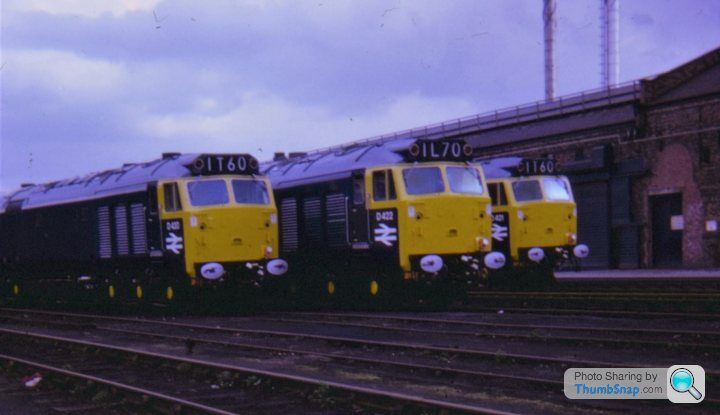
In 1966 Watford Junction station was used for a spot of night time filming for 'The Avengers' and given a fake nameboard....

Crewe station in 1968....

Euston station in 1966....

A Euston bound express passing the radio masts at Hillmorton south of Rugby in 1967, within a minute or two it will be entering Kilsby Tunnel....

Trent Valley Junction just north of Rugby about fifteen years ago, I was sat here for two hours due to a points failure further along the line....
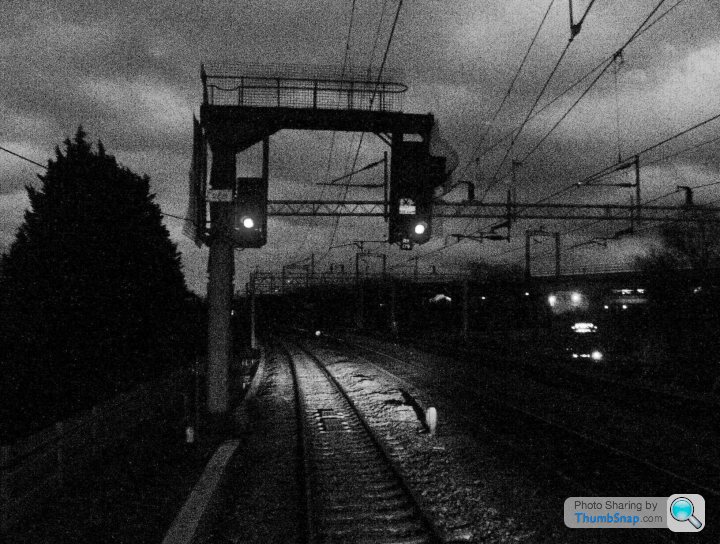
A Class 85 at Nuneaton....

The complete remodelling of Euston took place between 1963 and 1968 whilst everyday operations continued to run....




The 40s were a daily sight at Crewe for about twenty five years....

40 025 viewed from the cab of 40 024 near Preston in 1981....

Euston in the '70s....

Carlisle in 1970, when they first appeared the 50s were used singularly and in pairs on expresses north of Crewe until full electrification to Glasgow started in 1974....

Crewe in February 1963....

In 1964 steam, diesel and electric traction still ran side by side at Crewe....

Crewe North Stabling Point in 1969....

Euston in 1963....
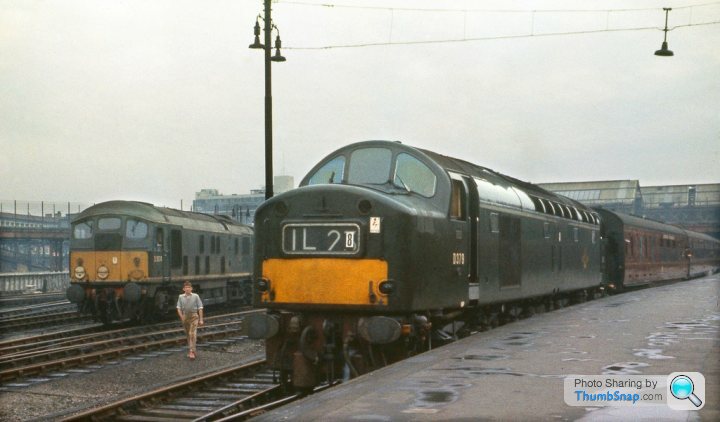
A rail tour chartered by the Locomotive Club of Great Britain waiting to leave Euston in 1967....


Crewe Works in 1971 - when the new diesel traction was first introduced the loco numbering system started at 1 (a Class 44 'Peak') and ended at 9021 (a Class 55 'Deltic') with large gaps between the various classes, in late 1972 a new five digit system was introduced based on the class number, this took a while to complete and some classes were in the process of being withdrawn and never received their new numbers. 401 became 50 001, 6977 became 37 277 and 263 became 40 063....

P5BNij said:
An interesting arrangement of headcode discs there (and only one headlamp actually switched on, it seems). Officially long out of use by 1981, but it does seem from old photos that some crews/depots/regions took a fancy to certain patterns. Unless that Class 40 has gone through a wormhole and is working empty coaching stock in the 1900s...Great pics (and commentary) as ever, P5B

P5BNij said:
Well the chances are I've driven 31s, 47s and 50s past your house at Taplow between 1983 and 1985! Funny you should post a pic of Slough - my other half's Dad started his railway career there in 1946 (still in GWR days then) as a 'booking boy' in Slough East signalbox, he stayed there until he left to do his national service in the RAF in 1951. When he left the RAF he was offered a job at Slough again but turned it down in favour of working for a photographic company, part of this job entailed visiting the drawing office at Swindon Works every few weeks to take orders and deliver photographic material, on many occasions he was allowed to wonder round the whole works taking as many photos as he liked so he saw the end of WR steam and the building of the Western hydraulics there in the '60s.
During those years, it is highly likely I would have seen a train you were thrashing!A question to the drivers; what is a typical day?
How far do you go?
Do you just go there and back?
Do you go there and back and there and back and there and back and there and back and there and back and there and back....? (DMU's and EMU's probably yes?)
Do you stay away from home?
On really long stints do you have a co-driver?
Lily the Pink said:
Being from the heart of WR territory, I very rarely got to see any electric locos, of the sort that from the above seems to have become class 86. Are any of them (or other pure electrics) still in use, or preserved ?
There are a few preserved electrics running around, this was taken today. 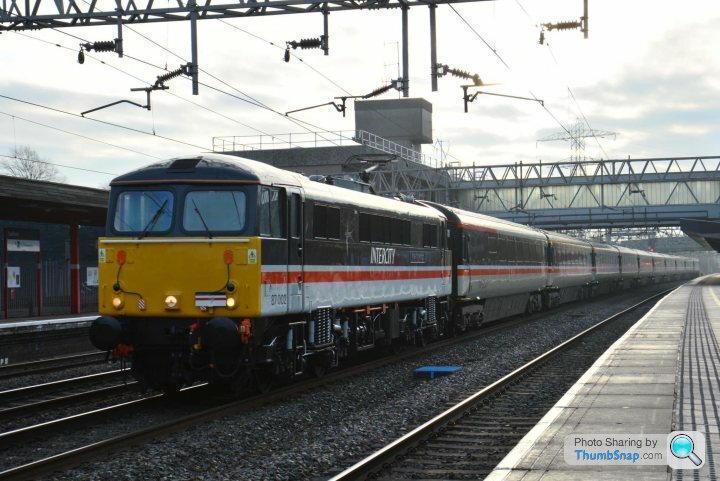
colin_p said:
P5BNij said:
Well the chances are I've driven 31s, 47s and 50s past your house at Taplow between 1983 and 1985! Funny you should post a pic of Slough - my other half's Dad started his railway career there in 1946 (still in GWR days then) as a 'booking boy' in Slough East signalbox, he stayed there until he left to do his national service in the RAF in 1951. When he left the RAF he was offered a job at Slough again but turned it down in favour of working for a photographic company, part of this job entailed visiting the drawing office at Swindon Works every few weeks to take orders and deliver photographic material, on many occasions he was allowed to wonder round the whole works taking as many photos as he liked so he saw the end of WR steam and the building of the Western hydraulics there in the '60s.
During those years, it is highly likely I would have seen a train you were thrashing!A question to the drivers; what is a typical day?
How far do you go?
Do you just go there and back?
Do you go there and back and there and back and there and back and there and back and there and back and there and back....? (DMU's and EMU's probably yes?)
Do you stay away from home?
On really long stints do you have a co-driver?
Most of our jobs are one way due to the nature of loading and unloading long heavy freight trains, we'll either travel to the start of a job somewhere or travel back afterwards, swapping over with other drivers most of the time. Most passenger drivers will do several trips in a shift, depending on the location and length of their shift. When my brother was based in Birmingham he used to do two return trips down to Bristol and back in a shift.
Occasionally we'll have a lodging turn if the job is booked for twelve hours and doesn't have enough travelling time at the start or finish, it doesn't happen that often thankfully (I like my home comforts!).
We don't have co-drivers as such but some of our jobs are double manned if they're top and tailed with a loco at each end, generally these are engineering trains which sometimes split into two on site.

colin_p said:
I've recently moved and am now in North East Derbyshire, where there are loads of abandoned railway lines which are now cycleways, I'm looking foward to exploring them when the weather gets a bit better.
If you haven't seen it already have a look at the youtube channel of Wobbly Runner, he does a lot of exploring along disused railway lines in NE Derbyshirehttps://www.youtube.com/c/WobblyRunner
Gassing Station | Boats, Planes & Trains | Top of Page | What's New | My Stuff





